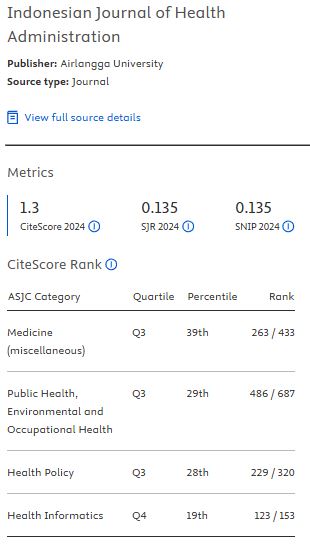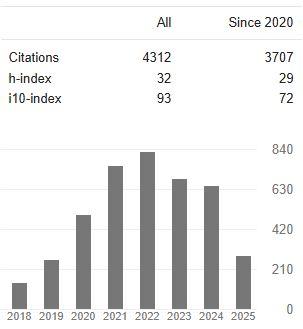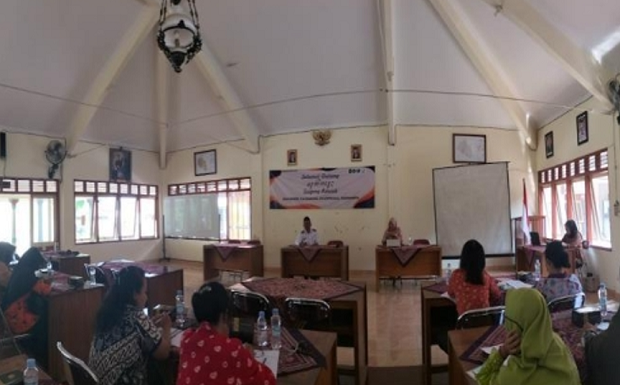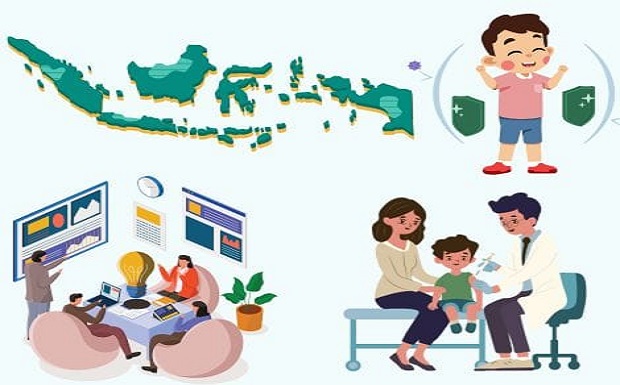THE CORRELATION BETWEEN DEMAND FACTORS AND HEALTH CARE SERVICE UTILIZATION BY CONTRIBUTION BENEFICIARY PATIENTS
Downloads
Background: National Health Insurance is the government's effort to increase public access to health care services. As the implementer of the National Health Insurance, the Outpatient Unit of Haji General Hospital, Surabaya has undergone the decrease of contribution beneficiaries' visits from 2010-2013. This condition indicates a decrease in health care utilization by the low-income community.
Aim: This study aims to identify the correlation between health care demands and health care utilization by the contribution beneficiary patients.
Method: The study was an observational analytic using a cross-sectional design. A systematic random sampling technique was used to determine the sample of the study. The respondents were 74 contribution beneficiary patients who possessed a district government free care scheme and had ever utilized the health care services at the Outpatient Unit of Haji General Hospital, Surabaya, and at least 13 years old. The data were collected through questionnaires and analyzed with Spearman and Chi-Square tests (α =0.05).
Results: Health status, insurance needs, additional costs, gender, ethnicity, education, and income did not have a significant correlation with the health care service utilization by the contribution beneficiary patients at the Outpatient Unit of Haji General Hospital. It was identified that the older the people are, the higher the frequency of health care utilization is. Besides, service time was proven to be the determinants of health care utilization (p = 0.006).
Conclusion: The most influential factors in utilizing the health care services by contribution beneficiary patients are service time and age. Based on those factors, the Haji General Hospital requires to improve its services and service timeliness for the elderly contribution beneficiary patients.
Keywords: demand, contribution beneficiary patients, utilization.
Folland, S., Goodman, A. C. and Stano, M. (2013) Teh Economics of Health and Health Care. 7th edn. New Jersey: Prentice Hall.
Laeliyah, N. and Subekti, H. (2017) ‘Waktu Tunggu Pelayanan Rawat Jalan dengan Kepuasan Pasien Terhadap Pelayanan di Rawat Jalan RSUD Kabupaten Indramayu', Jurnal Kesehatan Vokasional, 1(2), pp. 102–112.
Londo, J. P., Tucunan, A. A. T. and Maramis, F. R. R. (2017) ‘Hubungan antara Karakteristik Peserta BPJS Kesehatan dengan Pemanfaatan Pelayanan Puskesmas di Wilayah Kerja Puskesmas Tahuna Barat', Jurnal Kesehatan Masyarakat, 6(3), pp. 1–7.
Åyszczarz, B. (2017) ‘Gender Bias and Sex-Based Differences in Health Care Efficiency in Polish Regions', International Journal for Equity in Health, 16(1), pp. 1–13. doi: 10.1186/s12939-016-0501-y.
Napirah, M. R., Rahman, A. and Tony, A. (2016) ‘Faktor-Faktor yang Berhubungan dengan Pemanfaatan Pelayanan Kesehatan di Wilayah Kerja Puskesmas Tambarana Kecamatan Poso Pesisir Utara Kabupaten Poso', Jurnal Pengembangan Kota, 4(1), pp. 29–39. doi: 10.14710/jpk.4.1.29-39.
Putra, A. W. (2010) Analisis Permintaan Penggunaan Layanan Kesehatan pada Rumah Sakit Umum Milik Pemerintah di Kabupaten Semarang. Undergraduate Thesis. Universitas Diponegoro.
Rohmah, F. N. (2017) ‘Status Kesehatan dan Keteraturan Pemanfaatan Layanan Infertilitas', Jurnal Kebidanan, 6(1), pp. 56–62.
Sampeluna, Balqis, N. and Hamzah, A. (2013) ‘Faktor yang Berhubungan dengan Pemanfaatan Pelayanan Kesehatan di RSUD Lakipadada Kabupaten Tana Toraja', Jurnal Administrasi dan Kebijakan Kesehatan, 2(3), pp. 22–28.
Syarifain, A., Rumayar, A. A. and Mandagi, C. K. F. (2017) ‘Hubungan antara Pendidikan dan Pendapatan dengan Pemanfaatan Pelayanan Kesehatan oleh Pasien BPJS di Wilayah Kerja Puskesmas Sario Kota Manado', Jurnal Kesehatan Masyarakat, 6(4), pp. 524–531.
Tasya, N., Andriany, P. and Herwanda (2016) ‘Faktor-Faktor yang Berhubungan dengan Pemanfaatan Pelayanan Kesehatan Gigi dan Mulut di Rumah Sakit Gigi dan Mulut (RSGM) Universitas Syiah Kuala Banda Aceh', Journal Caninus Dentistry, 1(4), pp. 54–62.
Ulfa, Z. D., Kuswardinah, A. and Mukarromah, S. B. (2017) ‘Faktor-Faktor yang Mempengaruhi Pemanfaatan Pelayanan Kesehatan Maternal Secara Berkelanjutan', Public Health Perspective Journal, 2(2), pp. 184–190.
Ursulica, T. E. (2016) ‘Teh Relationship between Health Care Needs and Accessibility to Health Care Services in Botosani County- Romania', in International Conference – Environment at A Crossroads: SMART Approaches for A Sustainable Future. Bucharest: Procedia Environmental Sciences, pp. 300–310. doi: 10.1016/j.proenv.2016.03.035.
Wardana, B. K. and Suharto (2017) ‘Hubungan Pendidikan dan Pengetahuan Peserta BPJS di Kelurahan Rowosari dengan Pemanfaatan Pelayanan Kesehatan di Puskesmas Rowosari', Jurnal Kedokteran Diponegoro, 6(1), pp. 46–53.
Weeratunga, L. and Dissanayake, L. (2017) ‘Factors Influencing Demand for Healthcare Services Among Teh Elderly Women In Sri Lanka', International Journal of Advanced Research and Review, 2(4), pp. 35–47.
1. As an author you (or your employer or institution) may do the following:
- make copies (print or electronic) of the article for your own personal use, including for your own classroom teaching use;
- make copies and distribute such copies (including through e-mail) of the article to research colleagues, for the personal use by such colleagues (but not commercially or systematically, e.g. via an e-mail list or list server);
- present the article at a meeting or conference and to distribute copies of the article to the delegates attending such meeting;
- for your employer, if the article is a ‘work for hire', made within the scope of your employment, your employer may use all or part of the information in the article for other intra-company use (e.g. training);
- retain patent and trademark rights and rights to any process, procedure, or article of manufacture described in the article;
- include the article in full or in part in a thesis or dissertation (provided that this is not to be published commercially);
- use the article or any part thereof in a printed compilation of your works, such as collected writings or lecture notes (subsequent to publication of the article in the journal); and prepare other derivative works, to extend the article into book-length form, or to otherwise re-use portions or excerpts in other works, with full acknowledgement of its original publication in the journal;
- may reproduce or authorize others to reproduce the article, material extracted from the article, or derivative works for the author's personal use or for company use, provided that the source and the copyright notice are indicated.
All copies, print or electronic, or other use of the paper or article must include the appropriate bibliographic citation for the article's publication in the journal.
2. Requests from third parties
Although authors are permitted to re-use all or portions of the article in other works, this does not include granting third-party requests for reprinting, republishing, or other types of re-use.
3. Author Online Use
- Personal Servers. Authors and/or their employers shall have the right to post the accepted version of articles pre-print version of the article, or revised personal version of the final text of the article (to reflect changes made in the peer review and editing process) on their own personal servers or the servers of their institutions or employers without permission from JAKI;
- Classroom or Internal Training Use. An author is expressly permitted to post any portion of the accepted version of his/her own articles on the author's personal web site or the servers of the author's institution or company in connection with the author's teaching, training, or work responsibilities, provided that the appropriate copyright, credit, and reuse notices appear prominently with the posted material. Examples of permitted uses are lecture materials, course packs, e-reserves, conference presentations, or in-house training courses;
























